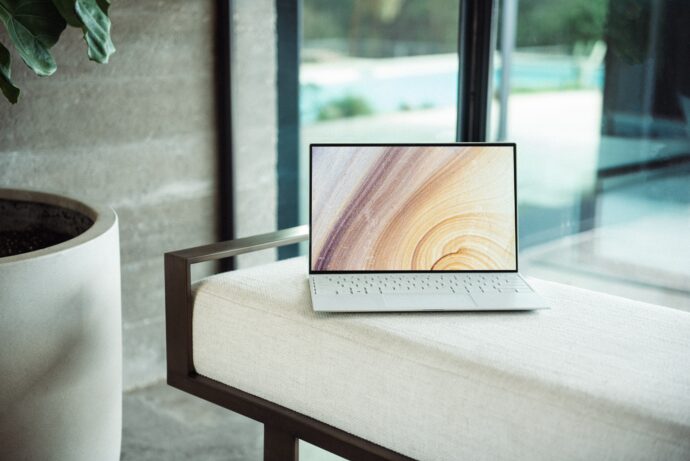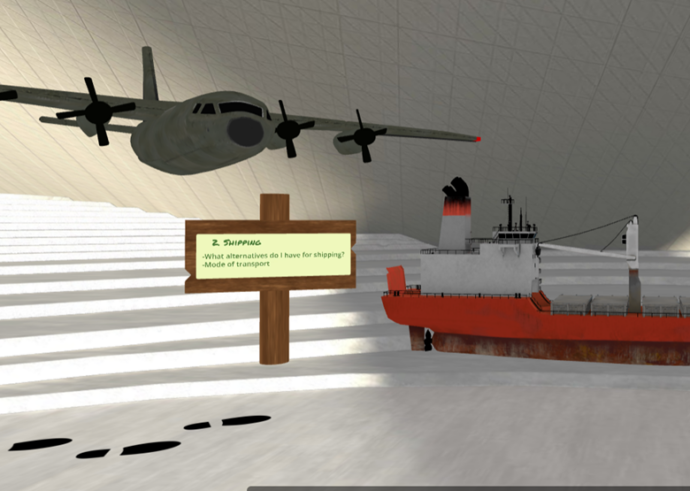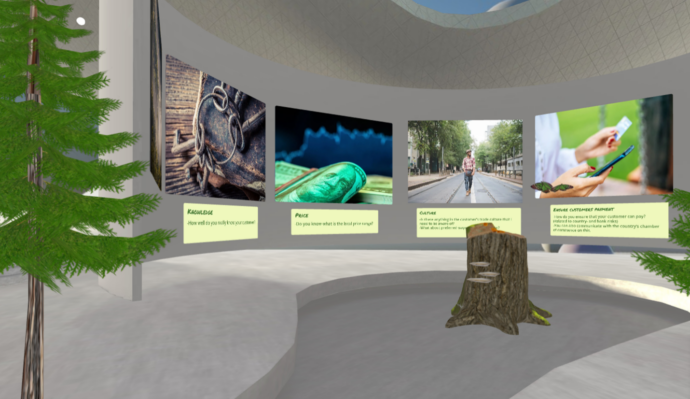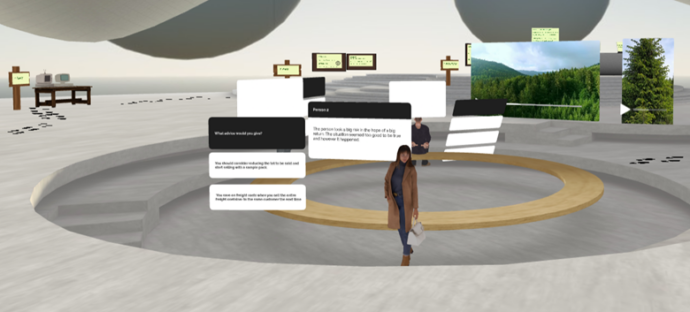Finnish micro-enterprises’ exports of goods are modest especially compared to our neighbours Sweden and Norway. The value of exports of goods of micro-enterprises was only 1.7 billion euros and accounted for 2,7 % of total exports in 2018. (Björk et al 2021.) Rapid growth and scalability for exports requires continuous learning and skills development. Microlearning effectively supports learning in the flow of work.
 Photo by Dell on Unsplash
Photo by Dell on Unsplash
Considering the fast-paced professional world microlearning is defined as impactful learning that takes place in small, easily absorbed chunks. Complex learning content or practical knowledge is broken down into bite-sized units that are easy to access, consume and incorporate into a daily routine and can thus be quickly digested even in the busiest of schedules. Microlearning is best used for just-in-time, not just-in-case, learning to keep up with the industry requirements.
A single element, a learning burst, usually contains a single learning objective so it allows learners to achieve one learning objective at a time. Learners easily engage with the learning content anytime and anywhere and decide when they prefer to learn new skills or improve topic comprehension. Typically, microlearning takes a few minutes at a time and is accessible on mobile devices. (Kumar 2022; Launikari 2022; Parkkonen 2022; Reji 2022; Tipton 2022; Zambito 2018.)
Microlearning theory is based on the forgetting curve introduced by German psychologist Hermann Ebbinghaus, which describes that people forget 80% of the knowledge they learn within a month (Valamis 2022). Microlearning tackles that challenge by helping learners to retain important information and prompting them to practice what they know (Reji 2022).
Additionally, microlearning has many other benefits that make it an ideal learning strategy for businesses:
- It enhances on-the-job training since it allows learners to gain knowledge and skills quickly and facilitates learning and development without interfering with learners’ regular routines (Dingari 2022; Habeeb 2017).
- It provides need-to-know knowledge that is essential for the job-performance and getting the job done instead of nice-to-know knowledge. Typically, people only have 20 minutes a week to delicate to learning and development. (Bersin 2017; Habeeb 2017.)
- It is designed for today’s workplace learners with short attention spans. Microsoft indicated that generally people lose concentration after eight seconds. (Habeeb 2017; McSpadden 2015.)
- The bursts of information can be in any format, e.g. short video, quiz, scenario, whiteboard animation, infographic, interactive PDF, micro podcast or game, which adds to learners’ interest (Habeeb 2017).
- It can be utilized at any stage of the learning cycle: pre-training, during the training, post-training (Habeeb 2017).
- The chunks can be standalone or a part of a larger repository of learning assets (Habeeb 2017).
VIVA makes micro-enterprises future-proof
The scarcity of skills and competences will be one of the key future challenges in the development of companies’ competitiveness. In the VIVA – Virtual Technologies Boost SME Exports project, funded by the Helsinki–Uusimaa Regional Council, microlearning was chosen as one of the methods to reduce companies’ export skills gaps. The VIVA project provides SMEs with a new way to simulate and practice export trade interactions. The project encounters export trade, modern technologies and continuous learning. Modern technologies refer to Augmented Reality (AR) and Virtual Reality (VR). (Heiskanen & Kuhmonen 2021.)
The aim of the “VIVA international trade agreement path” microlearning environment is to help a micro-enterprise gain adequate knowledge to learn how to negotiate a mutually beneficial trade agreement with the foreign buyer. Contract negotiations are preceded by careful pre-export homework and acid tests. These include, for example, market research and “know your customer” (KYC) procedures, which can also be practiced in the VIVA virtual reality learning environments.
The development work was carried out in seven workshops tailored for one micro-enterprise, who is generating new business after the COVID-19 pandemic and targeting export markets. Together with the company, in the co-creation process participated the VIVA team from Laurea UAS and the technology service provider. WondaVR was used as a tool for building the learning environment in the virtual reality.
A phased approach, utilized in the VIVA environment, is easier for a micro-entrepreneur to adopt and they can easily return to what they are learning at any time. The VIVA environment enables agile learning, which alternates between phases of learning and doing. Learning can take place at any time and from anywhere.
In the VIVA environment, the export process is outlined through the issues that need to be agreed during the international trade negotiations between the seller and the buyer, such as payment terms and conditions, Incoterms and financing. Those complex issues are broken down into small chunks to make them easier to digest. At the start of the trade negotiations, the objectives of the seller and the buyer may be very different. The concrete approach of the VIVA environment helps the seller to understand better the foreign buyer’s perspective and needs.
 Figure 1. The Viva international trade agreement path microlearning environment (Viva project 2022).
Figure 1. The Viva international trade agreement path microlearning environment (Viva project 2022).
The micro-entrepreneur learns how to draft the body of a commercial contract and how to find the necessary information and service providers. While it is good to have legal help to finalize the contract, it is important for the microentrepreneur to understand the key issues.
Skillful risk management, including a carefully designed risk-taking policy for your own company, plays an important role in the export process. Identifying and assessing risks, as well as protecting against them, and creating a risk-taking policy, can be practiced in Viva’s risk-taking policy environment that also consists of bite-sized chunks suitable for microlearning. (Kuhmonen, Heiskanen & Heino 2022.)
VIVA supports sustainable business
Micro-enterprises often have to spar with themselves, so the environment needs to be further developed in a way that it supports sustainable thinking and helps the entrepreneur to ask the right questions on the way towards green growth. Future work will also look at how a micro-entrepreneur could get more feedback from the VIVA environment. This will be built on the issues raised in the research on how to design engaging micro-learning:
- Find out how your target group would best benefit from microlearning.
- Make it easy-to-find.
- Come up with an attractive, click-worthy headline.
- Offer quick tips and baby steps – don’t overwhelm with too much information.
- Engage through interactivity.
- Give proper time to truly practice or grasp the skill.
- Make use of data checks.
- Connect the chunks to each other. (Bersin; Kumar 2022; Tipton 2022.)
 Figure 2. The Viva international trade agreement path microlearning environment (Viva project 2022).
Figure 2. The Viva international trade agreement path microlearning environment (Viva project 2022).
Microlearning will be enhanced and diversified as the VIVA project progresses, based on user experience and feedback This could be done, for example, by adding explainer videos, videos of experts answering specific questions, micro video lectures, animations or other attention- grabbing elements. Games and micro-challenges, such as multiple question quizzes, questions & responses and simulations could make microlearning more effective. Audio, PDF downloads and iconic Infographics i.e., graphic visual representations of information, data, or knowledge could also be utilized.
Gamification, for example, the award of digital badges, might give micro-entrepreneurs the feeling of achievement and satisfaction and incentive to continue microlearning. The tools that make learners to review what they’ve learned and facilitate retention are important. They could be quizzes or key takeaways. (Valamis 2022.)
 Figure 3. The Viva international trade agreement path microlearning environment (Viva project 2022).
Figure 3. The Viva international trade agreement path microlearning environment (Viva project 2022).
As a final outcome of the VIVA project, an easy-to-find and easy-to-use digital platform will be built. This “lightweight” usability allows for quick retrieval of information and a smooth learning path. It encourages businesses to continue to use the platform also after the end of the VIVA project. The “VIVA international trade agreement path” microlearning environment will be integrated into the open VIVA environment currently working under the name VIVA Export Skills Basecamp. Different types of learning methods will be utilized in the final VIVA environment.
In micro-enterprises, the resources for competence development are smaller than in larger ones, so it is important to utilize agile learning. Additionally, competence development in micro-enterprises mostly takes place while performing work tasks. Continuous on-the-job learning is supported by the VIVA project’s learning environments. The VIVA project offers a motivating and meaningful opportunity for microlearning and an easy-to-access way to develop export skills. The ultimate goal is to improve micro-enterprises opportunities to grow through sustainable internationalization and thrive in global markets in the long run.
Sources:
- Bersin, J. 2017. Watch Out, Corporate Learning: Here Comes Disruption. Retrieved: 12.11.2022: https://www.forbes.com/sites/joshbersin/2017/03/28/watch-out-corporate-learning-here-comes-disruption/?sh=2ae0be01dc59
- Björk, B., Kotavaara, O., Simunaniemi, A-M, Saarela, M & Muhos, M. 2021. Mikroyritysten viennin alueelliset erot ja kasvun mahdollisuudet – tarkastelussa Eurooppa, Itämeren alue ja Suomi. Oulun yliopisto. Kerttu Saalasti Instituutin blogi. Retrieved: 23.11.2022. https://www.oulu.fi/fi/blogit/kerttu-saalasti-instituutin-blogi/mikroyritysten-viennin-alueelliset-erot-ja-kasvun-mahdollisuudet-tarkastelussa-eurooppa-itameren
- The Definitive Guide to Microlearning. 2022. Retrieved: 7.11.2022. https://focusu.com/the-definitive-guide-to-microlearning/
- Dingari, S. 2022. 5 Reasons To Choose Microlearning For Corporate Training. Retrieved: 7.11.2022. https://blog.commlabindia.com/elearning-design/microlearning-reasons-choose-effective-corporate-training
- ELB Learning. 2022. An Introduction to Microlearning. Retrieved: 7.11.2022: https://blog.elblearning.com/an-introduction-to-microlearning
- EtonDigital. 2020. What Is Microlearning: 9 Benefits Of eLearning For Businesses. Retrieved: 7.11.2022: https://www.etondigital.com/what-is-microlearning-9-benefits-of-elearning-for-businesses/
- Habeeb Omer, A. 2017. What Is Microlearning And What Are The Most Important Microlearning Features? Retrieved: 7.11.2022: https://elearningindustry.com/most-important-microlearning-features
- Kuhmonen, A., Heiskanen, M. & Heino, P. 2022. Roadmap to the Export Trade Risk Management. Laurea Journal. Retrieved: 23.11.2022: https://journal.laurea.fi/roadmap-to-the-export-trade-risk-management/#0f9b3a12
- Kumar, N. 2022. 4 Advantages Of Microlearning For Your Organization. Retrieved: 7.11.2022: https://elearningindustry.com/advantages-of-microlearning-for-your-organization
- Launikari, M. 2022. The MUUVO project promotes the green transition and change management of companies through micro-learning and coaching. Laurea Journal. Retrieved: 23.11.2022. https://journal.laurea.fi/the-muuvo-project-promotes-the-green-transition-and-change-management-of-companies-through-micro-learning-and-coaching/#0f9b3a12
- McSpadden, K. 2015. You Now Have a Shorter Attention Span Than a Goldfish. Time. Retrieved: 11.11.2022: https://time.com/3858309/attention-spans-goldfish/
- Parkkonen, T. & Weaver, C. 2022. Effective Learning Experiences through Microlearning. Retrieved: 7.11.2022: https://www.edufication.com/effective-learning-experiences-through-microlearning/
- Reji, R. 2022. What Is Microlearning? +6 Examples to Inspire You (2023). Retrieved: 7.11.2022: https://whatfix.com/blog/microlearning-examples/
- Tipton, S. TrainingPros. 2021. What is Microlearning and 6 Markers That Make It Effective. Retrieved: 7.11.2022: https://blog.training-pros.com/insider-training/effective-microlearning/
- Valamis. 2022. Microlearning. Retrieved: 7.11.2022: https://www.valamis.com/hub/microlearning
- Zambito, V. 2018. Top 6 Benefits Of Microlearning Explained And Why It’s Effective. Retrieved: 7.11.2022: https://elearningindustry.com/benefits-of-microlearning-explained-why-effective-top-6